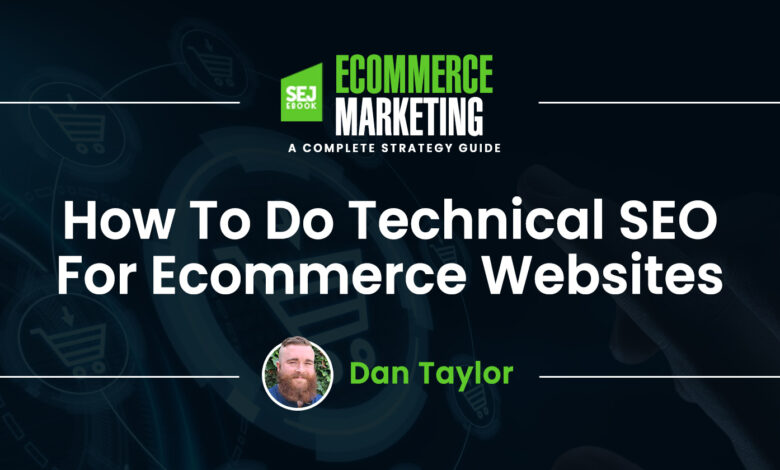How To Do Technical SEO For Ecommerce Websites

Over the past two years, many companies have moved to online forms due to changing market conditions.
Competition is heating up quickly in many sectors.
Some companies have done well with ready-made templates and e-commerce solutions. But with so much competition in search, you need to offer the best possible user experiences.
At some point, you’ll have to delve into the technical side of your website to avoid errors that can hurt search performance, especially if you’re considering migrating your site or moving away from off-the-shelf services.
Although you can run even large e-commerce stores on platforms like Shopify, you should still take some time to understand the technical tasks these platforms do for you.
A key part of this is technical SEO for e-commerce stores, which falls into two areas: technical competence and technical optimization.
Website architecture and URL structures
I use the term architecture vs site structure, as architecture often leads people to focus on just the structure of the URL.
The idea site structure should follow that of a standard catalog.
Indexes have been around for centuries.
If you go back over 100 years and look at the catalogs of Sears and Roebuck & Co. A classic of the 19th century, not much will change in how offline catalogs and even our e-commerce sites are structured today.
Years of iteration have effectively trained users to become familiar with this format, so by following a simple site structure of:
Home > Categories > Sub Categories > Products
It’s something users are familiar with and it makes sense. That should then skip to your URL structure, which should be consistent and descriptive of the page (to your users).
Products must also sit in a neutral subfolder of their respective categories, which means you can drag them into different related categories without creating a duplicate of the product page.
For example:
- Category page: example.com/category
- Sub category page: example.com/category/niche-1
- Product page: example.com/p/product-name or website.com/products/product-name
From experience, trying to create ecommerce URLs with keywords is not the way to “move the needle”.
If you use leading ecommerce platforms like Shopify and Salesforce Commerce Cloud, they force URL structures that include subfolders and product SKUs on you. These sites can totally compete with any other sites.
Sitemaps (XML and HTML) and Google Search Console setup
An HTML sitemap may not be strictly necessary for e-commerce websites to function, but it is a good idea. HTML sitemaps can allow for better internal linking to category and subcategory pages. They help keep track of and organize your pages and help users navigate your site.
It’s also not necessary to have an XML sitemap, but they can help Google discover the URL.
And when you crawl URLs connected to the Search Console API, you can also identify potential issues (eg a category page that is only found via XML sitemap and not through internal linking).
To get better (less filtered) data and more insights into the quality of your pages, you can:
- Submit your structured XML sitemaps to Google Search Console
- Add a Google Search Console property for each subfolder branch on your website: yoursite.com/clothing , for example.
This data can help you decide if you need to improve the value proposition and quality of specific category, subcategory, and product pages.
You can also incorporate a form of XML sitemap into your homepage design to provide a natural crawl path for PageRank scrolling from the homepage to categories and subcategories without spammy link lists, like this example from the MoneySupermarket.com homepage:
-
-
Screenshot from MoneySupermarket.com, July 2022
-
stock processing and 404s
When your products are out of stock, your product page templates will reflect this.
This can cause Google to interpret the page as a soft 404, removing it from indexing, which means you lose traffic and ranking for search terms associated with the page.
If a user is looking for a specific product and heads to your page only to find that they can’t purchase it, they will have a negative brand experience.
But, this is also an opportunity to sell other products or incentivize the user to wait until you have them back in stock.
You can do this through automation.
When a product template’s inventory level reaches zero, if it shows default Out of Stock messages, Google will mark it as a soft 404. To prevent this, fetch similar products and items on the product page to create a different value proposition. The user has instructions on what to do next, and you can prevent a soft 404 error.
For example, suppose your stock of Brand X HSS 3mm drill bits runs out. Add an automated check that replaces the “Out of Stock” message if you have similar products in stock. You can do this using a Product Information Management (PIM) system. Modify the template to show similar brands and products that meet the same or similar criteria – in this case, a 3mm drill bit.
If you also run physical stores, you can change the messages to “Out of stock online” and direct users to the store locator.
You can also create templates that use PIM to identify retail and cross-selling opportunities for other pages.
And if you use custom tags within PIM, you can direct customers to similar products through different variables (eg size, color, shape, release event).
These PIM integrations with product pages can also help prevent negative user experiences.
Using PIM data to add user value should be standard practice in optimizing your e-commerce store. Additional usability can help your product pages stand out against competitors, especially if your competitors have similar pages or value propositions.
structured data
Using structured data can help your ecommerce site’s products improve in search results by providing snippets that are rich in SERPs. It also presents clear information to the search engines, helping them to understand all the essential elements of the product (for comparison with competing websites).
Rich snippets can help improve click-through rates from SERPs to your pages, but they are not guaranteed.
for product pages, Product outline Important and empowering Rich snippet review.
For your category pages you can also use the ItemList schema. If you have local stores, you can include the LocalBusiness Planner on individual store pages.
In addition to the product schema, the site must also use other generic schema types, including:
- organisation.
- navigation path.
- website.
- Sitelinks search box.
A refined technical website provides a better user experience and can help you get an edge over the competition. If you want to learn more, check out SEJ’s Technical SEO Class or The Complete Ecommerce SEO Guide.
Featured Image: Paolo Bobita/Search Engine Magazine




